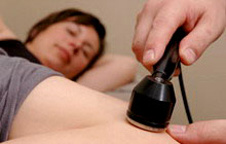Electrotherapy
Electrotherapy is therapy based on the use of electrical therapy equipment. Physiotherapists find these modalities useful when treating healing ligaments, tendons and muscles, and for alleviating pain.
Ultrasound is mainly used for acute soft tissue injuries. Sometimes, when ligaments heal on their own, they either form scar tissue which does not have good elastic properties, or the newly repaired collagen fibres have a less than optimal alignment. Physiotherapists use therapeutic ultrasound to help produce good quality collagen and then usually encourage exercise so that the repairing tissue aligns properly and allows good joint movement.
is mainly used for acute soft tissue injuries. Sometimes, when ligaments heal on their own, they either form scar tissue which does not have good elastic properties, or the newly repaired collagen fibres have a less than optimal alignment. Physiotherapists use therapeutic ultrasound to help produce good quality collagen and then usually encourage exercise so that the repairing tissue aligns properly and allows good joint movement.
Interferential is mainly used to control pain and swelling. Sometimes it feels like a tingling sensation or may even cause a muscle to contract.
TENS: This acronym stands for Transcutaneous Electrical Nerve Stimulation. A lot of research has gone into identifying the best stimulation frequencies for obtaining good pain relief. The higher frequencies achieve pain relief by a mechanism known as 'Pain Gating'. This feels like a gentle tingling sensation in the skin with the TENS signal travelling quickly in large fast-conducting nerves to the spinal cord. The pain from the injury travels more slowly in smaller nerves and by the time it reaches the spinal cord, the TENS signal has acted like a switch and ‘closed the pain gate’ so that the original pain can no longer be registered by the brain. The lower frequencies are a little less comfortable and feel more like a strong pulsing sensation. These signals are conveyed to the brain and produce a longer lasting pain relieving effect based on the release of our own natural morphine-like chemicals (endorphins).